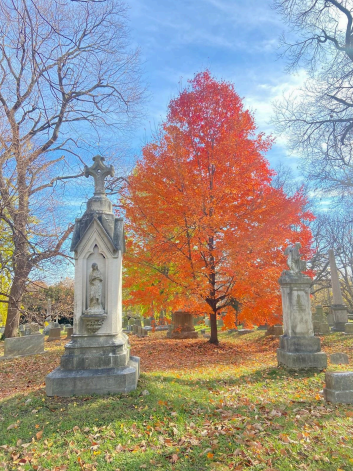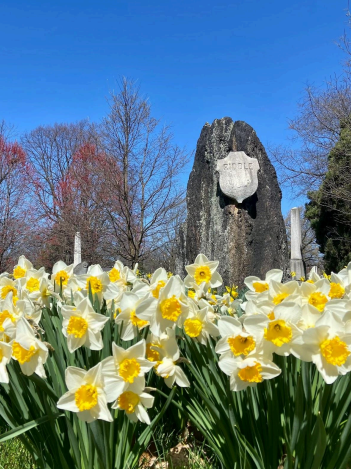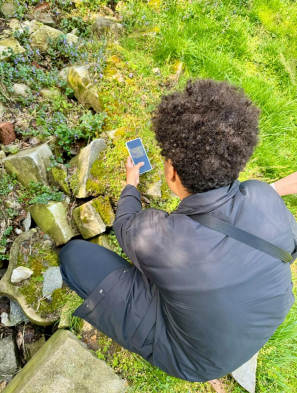
Explore Urban Wildlife: A Guide to Using iNaturalist
Using just an app, one Philly transplant reflects on how her phone, curiosity and desire to connect with nature led her to love discovering urban wildlife in a busy city.
Moving from the vast Sonoran Desert in Arizona to a metropolis like Philadelphia, I knew one of the hardest challenges would be connecting with nature in an urban environment. The endless, open landscapes were replaced by rowhome after rowhome, humans stacked together, seemingly devoid of wildlife. The early-morning birdsong and late-night howls of the coyotes were replaced with constant sirens and occasional fireworks.
As I yearned for a sliver of “wildness”, I realized that my new home would require me to redefine how I viewed and defined “nature”. This shift didn’t happen quickly, but I noticed the more intimate moments of nature, from the birds singing on powerlines outside my window to the giant, old trees providing sanctuary for squirrels in a nearby park. Through the seasons, I became attuned to subtle shifts, watching the squirrels fatten up for winter and the trees leafing out at the first signs of spring. One day it hit me: even in this big city, I was still surrounded by so much nature.
The Woodlands, an 18th-century pleasure garden and 19th-century cemetery located in West Philadelphia, quickly became my go-to escape. I could spend hours wandering the grounds, marveling at the massive trees and watching the groundhogs dart between their burrows after feasting on vibrant flowers.


The Woodlands in Fall (left) and Spring (right).
As I honed my ability to observe the intricate details of my surroundings, I started to notice wildlife thriving in sidewalk cracks and abandoned lots – each creating its unique ecosystem. The resilience of urban wildlife fascinated me as I wondered what plants were pushing through the cracks of old foundations.
Why is connecting to green spaces so important?
Engaging with nature isn’t just enjoyable; it’s vital to our health and wellbeing. The benefits are nearly endless, like how spending time outdoors can lower blood pressure and cortisol (a stress hormone) while improving mental health. It fosters relaxation, enhances concentration, and boosts creativity. Green spaces are also essential for cities as they help mitigate the effects of pollution, reduce the heat island effect, create habitat for plants and animals, reduce stormwater runoff, create spaces for community gatherings, and more.

How can you connect with urban wildlife?
Enter iNaturalist, an easy-to-use app that helps users identify flora and fauna through focused observations. A powerful tool for modern-day science, the cool thing about iNaturalist is that it turns everyone into a scientist. (Yes, really.) User-submitted observations create insightful datasets that researchers and scientists worldwide can use to monitor urban biodiversity health.
For users, iNaturalist offers a wealth of resources for budding naturalists, like tutorials to sharpen observation skills, area guides, and ways to connect with your local iNaturalist community.
iNaturalist also encourages us to get outside and connect with our local urban green spaces, deepening our sense of place. Learning through hands-on experience and connecting with like-minded individuals, naturalists, biologists, and professionals worldwide encourages us to advocate for protecting the natural spaces that plants and animals call home.
How do I use iNaturalist?
It’s easy. Download iNaturalist for free from the app store, and follow these instructions.
- Quality photos. A good photo is crucial to help other users identify what you find. If you prefer to use a camera, upload photos to the desktop version of iNaturalist.
- Multiple angles. It is essential to have multiple angles, especially with plants. For example, when identifying trees, upload photos of the bark, flowers, fruits, branches, leaves, and if possible, the entire tree.

- Use the AI feature to help identify. iNaturalist uses AI to help identify 55,000 different taxa. When you upload your photos, the app will suggest possible identifications based on visually similar observations in your area.
- Follow other users. You can find other local users in your desktop version of iNaturalist. This will help you see what others are finding and learn about nearby plants and animals.
- Take advantage of the desktop version. As you become familiar with different species in your area, you can start identifying other users’ observations to help make them research-grade. Once verified, these observations become valuable data used by scientists and researchers.
Where do I use iNaturalist?
Anywhere outdoors! Try any of these:
- Start in your backyard. Turn over rocks (gently and always return them to their original position), and look closely for insects, mushrooms, and more.
- Go on a leisurely walk around your neighborhood. Pay attention to things you may have never noticed before.
- Find your local green space. Whether you have large parks or small green spaces, both are valuable for the community and urban wildlife.
- Connect with new places while traveling. And if you’re like me, it’s almost like a game to “catch ‘em all” wherever you go!
Download iNaturalist today and pay close attention to the smallest insects, birds calling, and abandoned lots for wildlife rebounding and creating a novel environment. See you out there, explorers!

Cover photo by Aaron Burden on Unsplash. All other photos: Lauren Belcher





